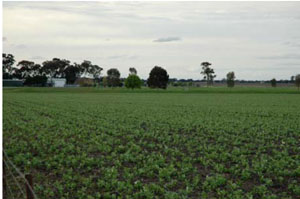IS25
Location: Haven
Australian Soil Classification: Calcic, Subnatric, Grey SODOSOL
Northcote Factual Key: Ug5.28
Great Soil Group: grey clay
Soil Type: Murtoa Clay.
General Landscape Description: Swale within a Dunefield
Geology: Quaternary Shepparton Formation: fluvial silt, sand and minor gravel

| IS25 Landscape |
Soil Profile Morphology:
Surface Soil
| A11 | 0-10 | Dark grey (10YR4/1); light clay; subplastic; cracking and self-mulching surface condition; weak coarse subangular blocky structure; very strong consistence dry; slightly sticky consistence wet; pH 6.6: | ||
| A12 | 10-20 | Dark grey (10YR4/1); medium clay; subplastic; cracking and self-mulching condition; weak coarse subangular blocky structure; very strong consistence dry; slightly sticky consistence wet; pH 7.7; sharp boundary to: | ||
| Subsoil | ||||
| B21 | 20-35 | Light brownish grey (2.5Y6/3); light medium clay; subplastic; moderate coarse blocky structure; very strong consistence dry; slightly sticky consistence wet; pH 8.1: | ||
| B22 | 35-90 | Pale olive (5Y6/3); medium heavy clay; very plastic; moderate coarse subangular blocky structure; very strong consistence dry; slightly sticky consistence wet; pH 9.1: | ||
| B23 | 90-135 | Pale olive (5Y6/3); medium heavy clay; very plastic; strong coarse subangular blocky structure; strong consistence dry; slightly sticky consistence wet; very few (<2%) soft carbonate segregations; pH 9.4: | ||
| B24 | 135-160 | Pale olive (5Y6/3); medium heavy clay; very plastic; strong coarse subangular blocky structure; strong consistence dry; slightly sticky consistence wet; pH 9.1; gradual boundary to: | ||
| B31 | 160-200 | Pale yellow (5Y7/4); heavy clay; very plastic; strong coarse subangular blocky structure; strong consistence dry; slightly sticky consistence wet; pH 8.9: | ||
| B32 | 200-220 | Pale yellow (5Y7/4); heavy clay; very plastic; strong coarse subangular blocky structure; strong consistence dry; slightly sticky consistence wet; pH 7.7. | ||
Chemical and Physical Analysis:
Horizon | Sample Depth cm | pH H2O | EC dS/m | Sodium Chloride % | Exchangeable Calcium cmol-/kg | Exchangeable Magnesium cmol-/kg | Exchangeable Potassium cmol-/kg | Exchangeable Sodium cmol-/kg | Total Nitrogen % | Exchangeable Acidity cmol-/kg | Organic Carbon % | Permanent Wilting Point -1500okPa | Coarse Sand % | Fine Sand % | Silt % | Clay % |
A11 | 0–10 | 6.6 | 0.17 | 0.02 | 8.6 | 4.7 | 2.1 | 0.2 | 0.16 | 5 | 1.8 | 13.5 | 16 | 39 | 10 | 34 |
A12 | 10–20 | 7.7 | 0.12 | 0.01 | 8.9 | 6.3 | 1.5 | 0.5 | 0.06 | 3.7 | 0.67 | 15.1 | 15 | 36 | 11 | 39 |
B21 | 20–35 | 8.1 | 0.14 | 0.02 | 7.1 | 6.6 | 1 | 1.9 | 0.04 | 3.1 | 0.42 | 15.3 | 14 | 39 | 11 | 35 |
B22 | 35–90 | 9.1 | 0.33 | 0.04 | 5.5 | 9 | 1.4 | 5 | 0.02 | 0.19 | 20.6 | 13 | 33 | 12 | 42 | |
B23 | 90–135 | 9.4 | 0.94 | 0.12 | 5.4 | 10.6 | 1.4 | 8.8 | 0.01 | 0.12 | 20.3 | 11 | 23 | 11 | 47 | |
B24 | 135–160 | 9.1 | 1.11 | 0.25 | 19.2 | 15 | 26 | 10 | 47 | |||||||
B31 | 160–200 | 8.9 | 1.21 | 0.2 | 19.7 | 11 | 28 | 11 | 47 | |||||||
B32 | 200–220 | 7.7 | 1.28 | 0.21 | 20.6 | 12 | 27 | 9 | 50 |
Management Considerations:
- Gradational profile, medium to heavy texture range with vertic properties.
- Neutral upper soil over alkaline and sodic subsoil. Slight decrease at depth.
- Upper soil (A horizons) indicate some organic matter content.
- Sodicity increases below upper subsoil (below 35 cm).
- Subsoil has yellow hue (5Y) and pale colours indicating reducing conditions, limited drainage and air movement.
- Landscape element, swale; very slow site drainage.
Profile Described By: John Martin, Nabil Badawy, Ron Cawood, Geoff Pope, John Galea, John Turner (1970).


